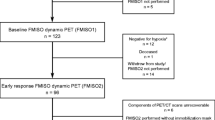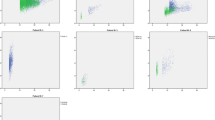Abstract
Purpose
Hypoxia is an important negative prognostic factor for radiation treatment of head and neck cancer. This study was performed to evaluate the feasibility of use of 18F-labelled fluoroazomycin arabinoside ([18F]FAZA) for clinical PET imaging of tumour hypoxia.
Methods
Eleven patients (age 59.6 ± 9 years) with untreated advanced head and neck cancer were included. After injection of approximately 300 MBq of [18F]FAZA, a dynamic sequence up to 60 min was acquired on an ECAT HR+ PET scanner. In addition, approximately 2 and 4 h p.i., static whole-body PET (n = 5) or PET/CT (n = 6) imaging was performed. PET data were reconstructed iteratively (OSEM) and fused with CT images (either an external CT or the CT of integrated PET/CT). Standardised uptake values (SUVs) and tumour-to-muscle (T/M) ratios were calculated in tumour and normal tissues. Also, the tumour volume displaying a T/M ratio >1.5 was determined.
Results
Within the first 60 min of the dynamic sequence, the T/M ratio generally decreased, while generally increasing at later time points. At 2 h p.i., the tumour SUVmax and SUVmean were found to be 2.3 ± 0.5 (range 1.5–3.4) and 1.4 ± 0.3 (range 1.0–2.1), respectively. The mean T/M ratio at 2 h p.i. was 2.0 ± 0.3 (range 1.6–2.4). The tumour volume displaying a T/M ratio above 1.5 was highly variable. At 2 h p.i., [18F]FAZA organ distribution was determined as follows: kidney > gallbladder > liver > tumour > muscle > bone > brain > lung.
Conclusion
[18F]FAZA PET imaging appears feasible in head and neck cancer patients, and the achieved image quality is adequate for clinical purposes. Based on our initial results, [18F]FAZA warrants further evaluation as a hypoxia PET tracer for imaging of cancer.




Similar content being viewed by others
References
Teicher BA. Angiogenesis and cancer metastases: therapeutic approaches. Crit Rev Oncol Hematol 1995;20:9–39.
Nordsmark M, Alsner J, Keller J, Nielsen OS, Jensen OM, Horsman MR, et al. Hypoxia in human soft tissue sarcomas: adverse impact on survival and no association with p53 mutations. Br J Cancer 2001;84:1070–5.
Brizel DM, Dodge RK, Clough RW, Dewhirst MW. Oxygenation of head and neck cancer: changes during radiotherapy and impact on treatment outcome. Radiother Oncol 1999;53:113–7.
Grosu AL, Piert M, Weber WA, Jeremic B, Picchio M, Schratzenstaller U, et al. Positron emission tomography for radiation treatment planning. Strahlenther Onkol 2005;181:483–99.
Vaupel P, Schlenger K, Knoop C, Hockel M. Oxygenation of human tumors: evaluation of tissue oxygen distribution in breast cancers by computerized O2 tension measurements. Cancer Res 1991;51:3316–22.
Stadler P, Becker A, Feldmann HJ, Hansgen G, Dunst J, Wurschmidt F, et al. Influence of the hypoxic subvolume on the survival of patients with head and neck cancer. Int J Radiat Oncol Biol Phys 1999;44:749–54.
Lehtio K, Eskola O, Viljanen T, Oikonen V, Gronroos T, Sillanmaki L, et al. Imaging perfusion and hypoxia with PET to predict radiotherapy response in head-and-neck cancer. Int J Radiat Oncol Biol Phys 2004;59:971–82.
Brown JM. The hypoxic cell: a target for selective cancer therapy—eighteenth Bruce F. Cain memorial award lecture. Cancer Res 1999;59:5863–70.
Koh WJ, Bergman KS, Rasey JS, Peterson LM, Evans ML, Graham MM, et al. Evaluation of oxygenation status during fractionated radiotherapy in human nonsmall cell lung cancers using [F-18]fluoromisonidazole positron emission tomography. Int J Radiat Oncol Biol Phys 1995;33:391–8.
Molls M, Feldmann HJ, Fuller J. Oxygenation of locally advanced recurrent rectal cancer, soft tissue sarcoma and breast cancer. Adv Exp Med Biol 1994;345:459–63.
Bentzen L, Keiding S, Nordsmark M, Falborg L, Hansen SB, Keller J, et al. Tumour oxygenation assessed by 18F-fluoromisonidazole PET and polarographic needle electrodes in human soft tissue tumours. Radiother Oncol 2003;67:339–44.
Vaupel P, Thews O, Kelleher DK, Hoeckel M. Current status of knowledge and critical issues in tumor oxygenation. Results from 25 years research in tumor pathophysiology. Adv Exp Med Biol 1998;454:591–602.
Nunn A, Linder K, Strauss HW. Nitroimidazoles and imaging hypoxia. Eur J Nucl Med 1995;22:265–80.
Krause BJ, Beck R, Souvatzoglou M, Piert M. PET and PET/CT studies of tumor tissue oxygenation. Q J Nucl Med Mol Imaging 2006;50:28–43.
Chao KS, Bosch WR, Mutic S, Lewis JS, Dehdashti F, Mintun MA, et al. A novel approach to overcome hypoxic tumor resistance: Cu-ATSM-guided intensity-modulated radiation therapy. Int J Radiat Oncol Biol Phys 2001;49:1171–82.
Dehdashti F, Mintun MA, Lewis JS, Bradley J, Govindan R, Laforest R, et al. In vivo assessment of tumor hypoxia in lung cancer with 60Cu-ATSM. Eur J Nucl Med Mol Imaging 2003;30:844–50.
Rasey JS, Hofstrand PD, Chin LK, Tewson TJ. Characterization of [18F]fluoroetanidazole, a new radiopharmaceutical for detecting tumor hypoxia. J Nucl Med 1999;40:1072–9.
Koh WJ, Rasey JS, Evans ML, Grierson JR, Lewellen TK, Graham MM, et al. Imaging of hypoxia in human tumors with [F-18]fluoromisonidazole. Int J Radiat Oncol Biol Phys 1992;22:199–212.
Thorwarth D, Eschmann SM, Scheiderbauer J, Paulsen F, Alber M. Kinetic analysis of dynamic 18F-fluoromisonidazole PET correlates with radiation treatment outcome in head-and-neck cancer. BMC Cancer 2005;5:152.
Hicks RJ, Rischin D, Fisher R, Binns D, Scott AM, Peters LJ. Utility of FMISO PET in advanced head and neck cancer treated with chemoradiation incorporating a hypoxia-targeting chemotherapy agent. Eur J Nucl Med Mol Imaging 2005;32:1384–91.
Lehtio K, Oikonen V, Gronroos T, Eskola O, Kalliokoski K, Bergman J, et al. Imaging of blood flow and hypoxia in head and neck cancer: initial evaluation with [15O]H2O and [18F]fluoroerythronitroimidazole PET. J Nucl Med 2001;42:1643–52.
Kumar P, Stypinski D, Xia H, McEwan AJB, Machulla H-J, Wiebe LI. Fluoroazomycin arabinoside (FAZA): synthesis, 2H and 3H-labelling and preliminary biological evaluation of a novel 2-nitroimidazole marker of tissue hypoxia. J Label Comp Radiopharmaceuticals 1999;42:3–16.
Piert M, Machulla H-J, Picchio M, Reischl G, Ziegler S, Kumar P, et al. Hypoxia-specific tumor imaging with 18F-fluoroazomycin arabinoside. J Nucl Med 2005;46:106–13.
Reischl G, Ehrlichmann W, Bieg C, Solbach C, Kumar P, Wiebe LI, et al. Preparation of the hypoxia imaging PET tracer [18F]FAZA: reaction parameters and automation. Appl Radiat Isot 2005;62:897–901.
Kinahan PE, Townsend DW, Beyer T, Sashin D. Attenuation correction for a combined 3D PET/CT scanner. Med Phys 1998;25:2046–53.
Eschmann SM, Paulsen F, Reimold M, Dittmann H, Welz S, Reischl G, et al. Prognostic impact of hypoxia imaging with 18F-misonidazole PET in non-small cell lung cancer and head and neck cancer before radiotherapy. J Nucl Med 2005;46:253–60.
Rischin D, Hicks RJ, Fisher R, Binns D, Corry J, Porceddu S, et al. Prognostic significance of [18F]-misonidazole positron emission tomography-detected tumor hypoxia in patients with advanced head and neck cancer randomly assigned to chemoradiation with or without tirapazamine: a substudy of Trans-Tasman Radiation Oncology Group study 98.02. J Clin Oncol 2006;24:2098–104.
Haffty BG, Hurley RA, Peters LG. Carcinoma of the larynx treated with hypofractionated radiation and hyperbaric oxygen: long-term tumor control and complications. Int J Radiat Oncol Biol Phys 1999;45:13–20.
Kumar P, Wiebe LI, Asikoglu M, Tandon M, McEwan AJ. Microwave-assisted (radio)halogenation of nitroimidazole-based hypoxia markers. Appl Radiat Isot 2002;57:697–703.
Markus R, Donnan GA, Kazui S, Read S, Hirano T, Scott AM, et al. Statistical parametric mapping of hypoxic tissue identified by [18F]fluoromisonidazole and positron emission tomography following acute ischemic stroke. Neuroimage 2002;16:425–33.
Rajendran JG, Mankoff DA, O’Sullivan F, Peterson LM, Schwartz DL, Conrad EU, et al. Hypoxia and glucose metabolism in malignant tumors: evaluation by [18F]fluoromisonidazole and [18F]fluorodeoxyglucose positron emission tomography imaging. Clin Cancer Res 2004;10:2245–52.
Gagel B, Reinartz P, Dimartino E, Zimny M, Pinkawa M, Maneschi P, et al. pO2 polarography versus positron emission tomography ([18F]fluoromisonidazole, [18F]-2-fluoro-2′-deoxyglucose). An appraisal of radiotherapeutically relevant hypoxia. Strahlenther Onkol 2004;180:616–22.
Yeh SH, Liu RS, Wu LC, Yang DJ, Yen SH, Chang CW, et al. Fluorine-18 fluoromisonidazole tumour to muscle retention ratio for the detection of hypoxia in nasopharyngeal carcinoma. Eur J Nucl Med 1996;23:1378–83.
Souvatzoglou M, Ziegler SI, Martinez MJ, Busch R, Dzewas G, Schwaiger M, et al. Standardised uptake values from PET/CT images: comparison with conventional attenuation-corrected PET. Eur J Nucl Med Mol Imaging 2006 Sep 5; [Epub ahead of print].
Schoder H, Erdi YE, Chao K, Gonen M, Larson SM, Yeung HW. Clinical implications of different image reconstruction parameters for interpretation of whole-body PET studies in cancer patients. J Nucl Med 2004;45:559–66.
Acknowledgements
We would like to thank B. Dzewas for her outstanding technical support. The study was funded by the Deutsche Forschungsgemeinschaft grant Pi 242/3-1 and MA 1096/5-1.
Author information
Authors and Affiliations
Corresponding author
Rights and permissions
About this article
Cite this article
Souvatzoglou, M., Grosu, A.L., Röper, B. et al. Tumour hypoxia imaging with [18F]FAZA PET in head and neck cancer patients: a pilot study. Eur J Nucl Med Mol Imaging 34, 1566–1575 (2007). https://doi.org/10.1007/s00259-007-0424-3
Received:
Accepted:
Published:
Issue Date:
DOI: https://doi.org/10.1007/s00259-007-0424-3




